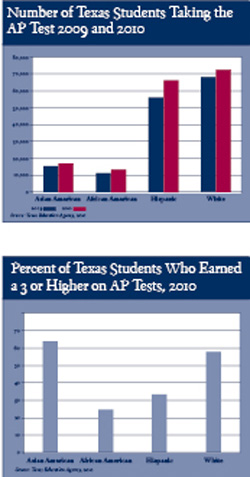• by Albert Cortez, Ph.D. • IDRA Newsletter • January 2011 •
 Advanced Placement Results
Advanced Placement Results
The Texas Education Agency (TEA) recently reported on the number of Texas students who took one or more Advanced Placement (AP) tests in 2010 and their performance on this measure of college readiness (2010a). On the whole, the news was encouraging. The number of students taking one or more AP exams rose to 179,320, which was a 12.8 percent increase from the previous year. Even more encouraging were the data showing that the number of minority students taking the exams had grown by 17.3 percent for African American students and by 18.1 percent for Hispanic students. (See graph below.)

Also encouraging was the revelation that the number of students who scored a 3 or higher on AP exams had gone up to 153,539, a net increase of 11 percent. This is important because many colleges require a score of at least 3 to consider granting college-level credit for those courses, giving those students a jumpstart on college credit hours and saving families thousands of dollars in tuition costs.
However, not all of the data were encouraging. A critical observation is that, while more students are enrolling in and taking AP classes in Texas schools, the majority are not earning the coveted 3 or higher score. Texas students took 325,571 exams, but the group scored a 3 or higher on only 153,539 of those assessments. This figure means that less than half (47.2 percent) scored at levels reflecting a high degree of mastery of the AP course content.
The varying rates for different groups spark even greater concern. The serious gap observed in graduation and college enrolments between Texas’ White students, Hispanic students and African American students is mirrored in AP stats. While three out of five White students earned AP scores of 3 or higher, only two out of five Hispanic students and just one out of four African American students earned comparable scores.
SAT and ACT Results
The need for expanding efforts to better prepare Texas students for college also is reflected in recent reports of Texas students’ SAT and ACT performance. The encouraging news reported by TEA is that in 2010 more Texas students took the SAT or ACT college entrance exams, as was the case with AP classes.
On the SAT, the number of test takers increased from about 107,000 to 117,000 (8.8 percent). Also encouraging was the fact that the increase in test taking was highest among minority students, where 10 percent increases in numbers of test takers were twice those among White students.
Similar increases in the overall numbers of test takers were reported on the ACT exam in 2010. According to TEA, “92,615 students in the class of 2010 took the ACT compared to 82,640 members of the class of 2009, a net gain of 12.1 percent over the prior year” (2010b&c). The state also reported that in 2010 a total of 188,209 high school underclassmen took the ACT exam, which was an 18 percent increase over the number of students taking the exam in 2009.
On the negative side, the comparison of mean SAT scores for the state’s major student sub-groups indicates the persistence of notable gaps in the scores. In 2010, the average SAT reading scores for White test takers was 522 compared to 452 for Mexican Americans (a 70-point gap) and 433 for “Other Hispanic” students (an 89-point gap). The performance gap was even higher for African American test takers, whose average reading score was 424, reflecting a gap of 98 points.
The performance gap also was evident in SAT math scores, where the mean score for White students was 543, compared to 476 for Mexican American students (a 76-point gap) and 457 for “Other Hispanics” (an 86-point gap), and 437 for African American students (a 106-point gap).
On the ACT exam, TEA reported that in 2010 the average composite score for White students was 23.1, while the average score for Hispanic students was 18.3 and for African American students was 17.3.
Implications
On the positive side, it appears that state and local school efforts to expand minority student participation in AP classes and to encourage them to sign up for and take the ACT and SAT exams does seem to be having a positive impact.
Data on student performance, however, indicate that simply getting more students into AP classes or taking the college entrance exams is not enough. While some small gains have been made in both areas, the achievement gaps among minority students and White students meeting criterion standards on the college entrance exams indicate that more targeted improvement is needed. Otherwise, the state will continue to struggle to meet its college enrollment and graduation goals outlined in the Texas Higher Education Coordinating Board’s ambitious Closing the Gap (CTG) targets (2000).
According to the coordinating board’s latest progress report: “In the first nine years of CTG, statewide participation increased by 401,476 students. That leaves the state with six years to close 36 percent (or 229,007) of the 630,000-student gap in enrollment by 2015… Hispanics had the largest numeric and percentage increases in enrollment from 2000 to 2009 among the three major ethnic groups. But with a participation rate of just 4.4 percent of Texas’ total Hispanic population in 2009, their enrollment lags the most in meeting the CTG participation target” (THECB, 2010).
Given that Hispanic students also constitute the largest and fastest growing proportion of Texas school population, this lag in meeting targets portends serious under-education issues for the state over the long term. The state’s failure to meet its higher education goals will have serious social and economic implications that will impact not only the state’s minority communities but all persons residing in the state over the next few decades.
Among the issues worthy of examination is the quality of AP offerings being provided to different student groups within and across school districts, including credentials and experience of teachers delivering those AP classes. On the college entrance exam issue, it may be necessary to re-assess the quantity and quality of any supplementary support being provided to ACT and SAT test takers in Texas high schools. While there are costs associated with most efforts to improve test taking and performance, failure to address these critical issues in the near future has even greater long-term (and negative) consequences for everyone in this state.
Other changes needed may include the creation of state and local goals on the numbers of students taking AP and college entrance exams and related goals for the percentages of students scoring at 3 or higher on AP exams as well as targets for the number of students scoring at or above criterion levels on college level exams.
Finally, while goal setting may provide visible targets and measures of progress toward students’ college readiness, it is important to recognize that all facets of school operation are inter-related (see Robledo Montecel & Goodman, 2010) and require coordinated efforts that include governance and school leadership, teacher preparation and support, equitable funding, and parent engagement to meet those stated goals. Especially in an economy as constricted as it seems to be in Texas, investment in today’s future workforce will pay great dividends over the long term, just as neglecting the promise of increasing college enrollment will create long-term costs and lost revenues.
Resources
Robledo Montecel, M., & Goodman, C.L. (eds). Courage to Connect – A Quality Schools Action Framework (San Antonio, Texas: Intercultural Development Research Association, 2010).
Texas Education Agency. “Texas experiences exceptional increases in Advanced Placement program,” TEA News Release (Austin, Texas: Texas Education Agency, September 14, 2010).
Texas Education Agency. “Texas leads nation in SAT participation increase,” TEA News Release (Austin, Texas: Texas Education Agency, September 13, 2010).
Texas Education Agency. “Texas math and science ACT scores increase; Composite score holds at record level,” TEA News Release (Austin, Texas: Texas Education Agency, August 18, 2010).
“Texas offers free SAT/ACT tests to high school juniors,” TEA News Release (Austin, Texas: Texas Education Agency, March 31, 2010).
Texas Higher Education Coordinating Board. Closing the Gaps by 2015 (Austin, Texas: Texas Higher Education Coordinating Board, October 2000).
Texas Higher Education Coordinating Board. Closing the Gaps Progress Report 2010 (Austin, Texas: Texas Higher Education Coordinating Board, June 2010).
Albert Cortez, Ph.D., is director of policy at IDRA. Comments and questions may be directed to him via e-mail at feedback@idra.org.
[©2011, IDRA. This article originally appeared in the January 2011 IDRA Newsletter by the Intercultural Development Research Association. Permission to reproduce this article is granted provided the article is reprinted in its entirety and proper credit is given to IDRA and the author.]


